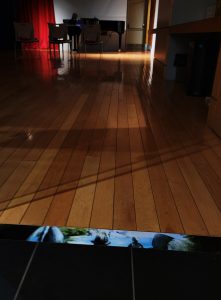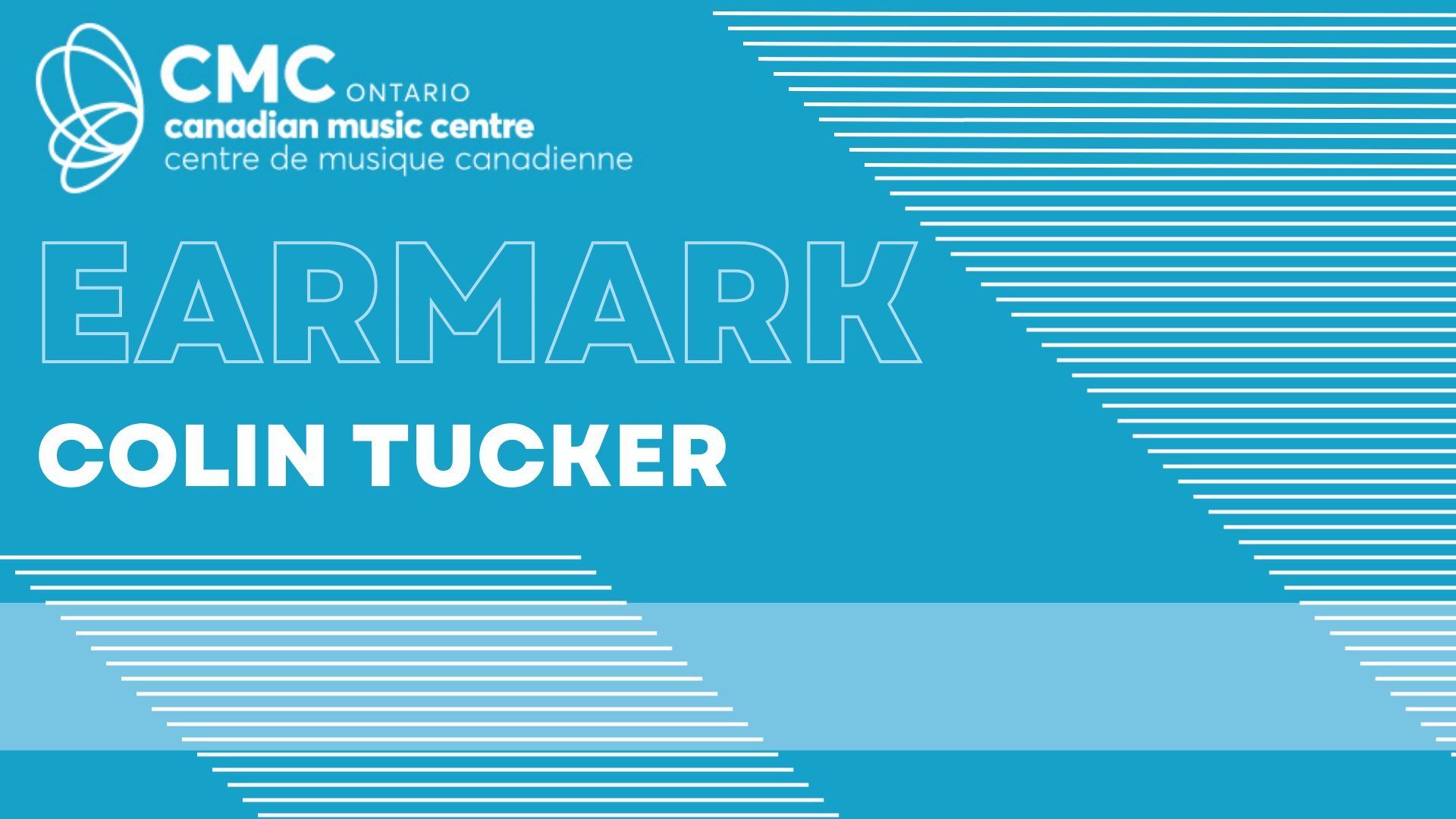In this instalment of Earmark, we catch up with Associate Composer Colin Tucker about their idiosyncratic and all encompassing approach to composition and text scores and how they relate to positionality, critical theory, and decolonization – including an upcoming work at the CMC in Toronto!
What are your plans as we ease out of the pandemic? How has your form of artistic practice changed?
The pandemic has intensified two mutually-reinforcing shifts in my work, both of which were in motion before the pandemic. First, I’ve come to embrace a much wider range of media, sensory modalities, and presentation forms than in earlier work: I’ve learned video and image editing (due in part to venue closures at the outset of the pandemic), thematized visual, tactile, and multi-sensory situations, and explored presentation forms far removed from those of the concert hall, white cube, and audiovisual media. In turn, this has facilitated a broader shift in my approach to making art: I usually do not proceed creatively from a given instrumentation or presentation form, but instead begin with a politicized inquiry, which leads me to particular “archives” (i.e. found media, objects, and infrastructures), and then to specific strategies of reframing those archives; only after making decisions regarding the latter two issues do I make choices about media and presentation formats.
Second, I’ve become explicitly engaged with Black and Indigenous critical theory, deliberately prioritizing its frameworks over those of historically white artistic protocols. From theorizations of racializing mechanisms inherent in modern subjectivity in the writing of Denise Ferreira da Silva, Calvin Warren, Saidiya Hartman, and Hortense Spillers, to analytics of whiteness and/as possession in the work of Aileen Moreton-Robinson (Goenpul Nation), to excavations of how colonizing logics subtend manifold aspects of Western modernity in the scholarship of Jodi Byrd (Chickasaw Nation), these fields have challenged much of what I thought I knew about Western art music, and indeed about Western modernity. As a settler who is read as white, it has been important to me to work out position- and power-sensitive ways to engage with this work, a topic I’ve written more about here.
My ability to engage with these fields of knowledge has actually been crucially enabled by my altered approaches to media, sensation, and presentation forms. These technical changes have allowed me to engage with a wider range of archives and to recontextualize those archives with greater flexibility than would be possible within the formalist defaults of concert music, while also opening up the possibility of approaching spectatorial protocols and infrastructures not as unmarked (i.e. taken-for-granted) norms but as objects of critical interrogation. These shifts have facilitated the three broad projects on which I am currently at work:
- critical mappings of concert music spectatorship’s participation in the necro-biopolitics of sensation through event scores (codifying activities with a wide range of media) and essays aligned with Black and Indigenous studies methods
- markings of colonial grammars of territorial possession in settler/colonizer everyday spaces on occupied Turtle Island through place-based interventions and artist books guided by Indigenous studies frameworks
- with the curatorial project Null Point (of which I am founding artist director), critical, against-the-grain interpretations of canonical white settler experimental music scores through performances and exhibitions focused on mapping coloniality embedded in these scores through Black and Indigenous studies analytics
What have you been listening to lately? Does any of this make its way into your music?
As my recent work is engaged critically with spectatorial listening and perception, I don’t spend a great deal of time with fixed-media, non-situated work for modern Western audiovisual media. For example, in my studies of other artists’ work, I am presently especially interested in the possibilities of the book-length collection of text scores, and particularly how this form can not only support radical individual works but can also point, more ambitiously, towards otherwise fields of knowledge. This is due in part to the form’s flexibility: in the myriad possibilities of textual notation, the juxtaposition of multiple media (text, image, drawing, diagram, etc.), and the combination of scores with other genres of writing (artist statements, scholarly writing, performance instructions, etc.). Salient (for me) recent publications in this vein include Mendi and Keith Obadike’s BIG HOUSE / DISCLOSURE and Dylan Robinson’s (Stó:lō/Skwah First Nations) Hungry Listening: Resonant Theory for Indigenous Sound Studies. As an artist engaged in critique of white/settler/colonizer positionality, the significance of these works for me lies in how they mark the fraught politics of quotidian materials, architectures, and territorial relations on occupied Turtle Island, which remain unmarked in most white settler experimental music. I read both publications as radical challenges (in their distinct ways) to the depoliticized, dehistoricized positivism of white settler experimental music frameworks, challenges to which I am accountable to respond.
What is the most important lesson you would share with your younger self in regards to your music?
When I was younger, I operated from a naïve understanding of how music circulates and acts in the world, specifically a Humanist understanding which grossly overestimated the agency of composerly intention. While this understanding assumed that received musical infrastructures (of notation, performance, listening, criticism, publicity, etc.) were neutral conduits for the transmission of composerly intention, I now realize the importance of accounting for how the partial and interested affordances of musical infrastructures mediate the dissemination of composerly intention. In response to the need to account for the mediating effects of musical infrastructures, I compiled this reading list.
There are plenty of constructive models for artistic practice that take as axiomatic the partiality and interestedness of artistic infrastructures, particularly from artists and scholars in contemporary art. Yet these approaches are often not legible on their own terms within the field of concert music (even in its updated “contemporary” and “experimental” forms). So, I would advise my younger self to actively seek out knowledge not only from contemporary art, but also more broadly from multiple fields, multiple kinds of institutions/affiliations (including those at the margins of the white, bourgeois Public Sphere), and multiple types of knowledge (including those not amenable to codification through modern Western print or audiovisual media), while being aware of matters of positionality and power in engaging with historically marginalized fields of knowledge. This approach is needed because no one field will have all the answers, and because fields often align with emancipatory social movements at different rates (in this respect, music is chronically behind art). This approach is also necessary because fields shaped by positions of social privilege tend towards a politically-interested ignorance; the writing of Manu Vimalassery et al. on “colonial unknowing” and the work of the late Charles Mills on “white ignorance” have been useful to me in unpacking how a colonialist, white supremacist ignorance is a feature rather than a bug of historically white fields of knowledge.
Tell me about a project/work of yours that you particularly believe in.
In the past two years I’ve made, for the first time in my life, work that I really believe in, both artistically and politically. My ideal is to make concise, clear interventions that thematize the relational content of unmarked, routine protocols, denaturing those protocols while mapping their (power-differential) relationality. At present, I’m pursuing this primarily in “everyday” settler/colonizer spaces on occupied Turtle Island, and in the concert hall. A strong (for me) example of the former is the piece in the wake of the santa maria, realized as an audio intervention in public space and as a video (see below). This piece positions perpetrators of global warming within long histories of imperialism through interventions in proximity to carbon-producing infrastructure, with audio footage of ocean waves re-edited from a “relaxing Caribbean beach” video which alludes to literal wakes of colonizers’ ships (such as the santa maria taken by Christopher Columbus) and to historical wakes of conquest such as global warming-caused rising sea levels. Through an intervention with a title and audio, the piece offers a concise but radical reframing of “mundane” practices and spaces, while also contesting (white settler) discourses on environmentalism and experimental music. I wrote in depth about the stakes of the piece in its program note.
As for my works around concert halls, I would encourage people to experience my site-specific concert hall interventions in person this spring at the CMC’s Chalmers House space in Toronto/Tkaronto. The interventions and performances featured in this event are my favorite works for/against concert halls; I hope that they offer simultaneously 1) robust and disorienting refusals concert music business-as-usual, and 2) concise markings of relations intrinsic to defaults of concert music spectatorship. The image below shows a piece featured in the installation, before Art elevates, which reads the influential yet critically uninterrogated aesthetic writings of WH Wackenroder through analytics of Black study scholar Denise Ferreira da Silva. Taking as axiomatic Silva’s canonical analysis of how relations of domination are intrinsic to the modern Western subject, the piece excavates how Wackenroder writes the spectator’s transcendence of the Everyday’s exteriority (monotony, triviality, etc.) through a displacement of this exteriority onto racially-marked figures, and implicates this reading within concert hall architectures by marking thresholds between Aesthetic and Everyday space with found images indexical of the broader imperial horizons of Wackenroder’s racializing gesture. I’m grateful for the support of the CMC and particularly Joseph Glaser in realizing this unconventional project.


